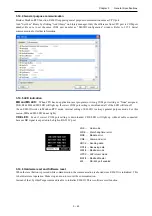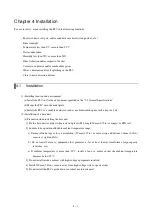
Chapter 4 Installation (hardware)
4 – 4
4.3
Wiring
(1) Separation of power system
Several different power sources are used with PLC, such as main power of PLC, power for I/O signal and power
for external devices. These power sources should be separated as much as possible.
If these power sources come from one power source, install transformers or noise filters to separate those power
lines as much as possible.
NF
Main power supply
100 V AC
to
200 V AC
Transformer
Power for PLC unit
NF: Noise filter
NF
Transformer
Power for I/O signals
NF
Power for general equipment
Figure 4.3 Example of power system diagram
(2) Fail safe
1] Construct an interlock circuit outside the PLC.
When the PLC power supply is turned ON/OFF, the lag time and the difference in the startup time between
the PLC unit power and the external power (particular DC power supply) for the PLC I/O module signals
may temporarily cause the I/O not to operate normally.
Do not control the power for the EH-YR12 relays to have it perform an interlock with the external load, etc.
The relay may turn on even when the power has not been supplied by an aluminum electrolytic capacitor
inside the module to drive the relay.
Also, it is conceivable that a fault in the external power and a failure in the PLC unit lead to abnormal
actions. To prevent such actions from causing abnormal operation the entire system, and from a point of
view of creating a fail safe mechanism, construct circuit such as an emergency stop circuit, the protect
circuit, and the interlock circuit, for the sections that lead to a mechanical breakdown and accident from
abnormal actions outside the PLC.
2] Install a lightning arrester
To prevent damage to equipment as a result of being struck by lightning, we recommend setting up a
lightning arrester for each PLC power supply circuit.
The power supply module detects power failures from a voltage drop of the internal 5 V DC power supply.
For this reason, the load in the 5 V DC power of the unit is light, the 5 V DC is retained for a long time and
operations may continue for more than 100ms. Therefore, when using the AC input module, an OFF delay
timer for coordinating with the internal 5 V DC is needed because the AC input signal turns off more quickly
than the internal 5 V DC.













































